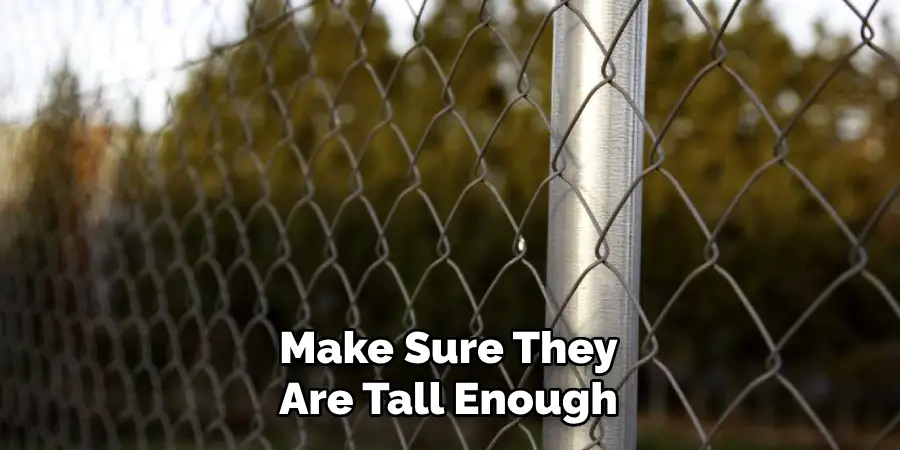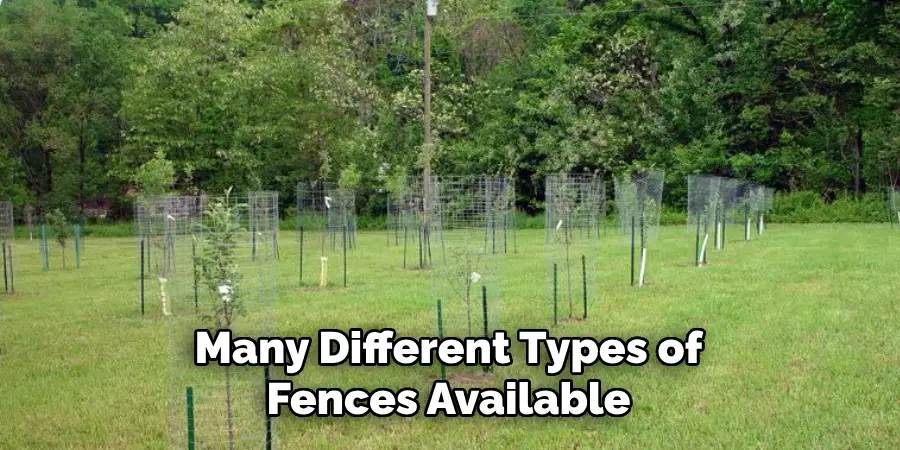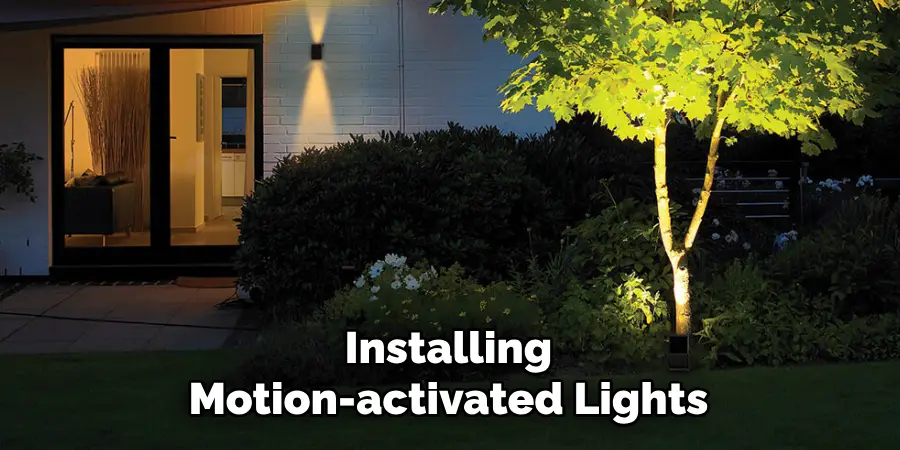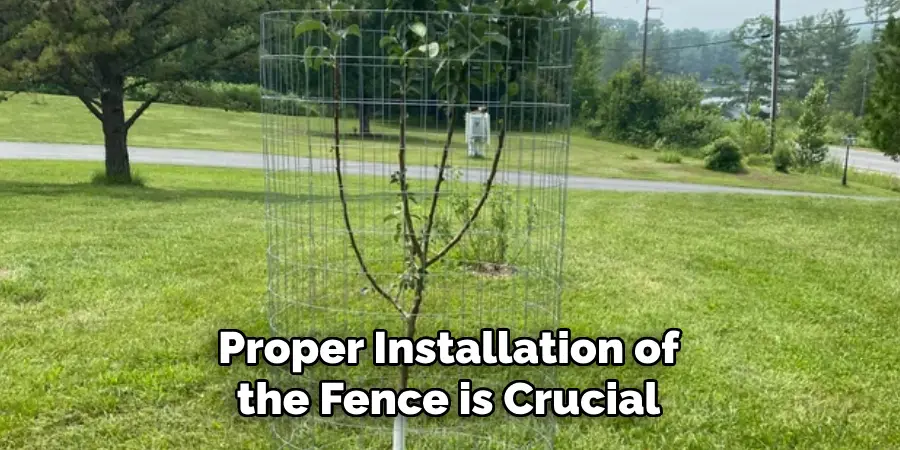Apple trees are a popular choice for backyard gardens and orchards, providing delicious fruit for eating fresh or making homemade treats.

However, deer can also see these trees as a tasty snack and may nibble on the leaves and bark, causing damage to your beloved apple trees.
Fortunately, there are effective ways to protect your apple trees from deer. In this guide, we will discuss how to fence apple trees from deer, including the materials and steps needed to create a sturdy and reliable barrier. So, let’s get started!
Why Do You Need to Fence Apple Trees From Deer?
Deer are known to be voracious eaters and can cause significant damage to apple trees. They will often strip the bark from young trees, which can stunt their growth or even kill them. Additionally, deer may also nibble on the leaves and branches of mature apple trees, reducing their ability to produce fruit.
Fencing your apple trees from deer can also prevent them from rubbing their antlers against the trunks, which can cause further damage. By creating a physical barrier, you are protecting your investment and ensuring that you will have a healthy and bountiful harvest.
Tools and Materials You Will Need to Fence Apple Trees From Deer
1. Mesh fencing (such as chicken wire or deer netting)
2. Wooden stakes
3. Hammer
4. Staples or zip ties
5. Wire cutters
6. Protective gloves and eyewear (optional)
7. Measuring tape
8. Garden shovel or post hole digger
9. Tension wire (optional)
Step-by-step Guidelines on How to Fence Apple Trees From Deer
Step 1: Measure and Plan

Before you start building your fence, measure the circumference of your tree trunk and add an extra foot to allow for growth. Then, determine how much fencing material you will need by measuring the distance between each tree and accounting for any corners or turns in your fence line. If you are using tension wire, measure and cut it to the desired length as well.
Step 2: Prepare the Area
Clear any debris or vegetation around your apple trees, making sure there is enough space for you to work comfortably. If necessary, use a garden shovel or post-hole digger to dig holes for the wooden stakes.
These will serve as anchors for your fence. Preparing the area will make it easier to install the fence and ensure that it is secure. This will also help you avoid any potential damage to your trees.
Step 3: Install the Wooden Stakes
Take your wooden stakes and hammer them into the ground, leaving approximately one foot above the surface. Place them around the circumference of each tree, spacing them evenly.
If you are using tension wire, make sure to leave enough space between each stake for it to be threaded through later on. While you can use any type of wooden stake, we recommend using pressure-treated or rot-resistant wood for durability.
Step 4: Install the Fencing Material

Take your mesh fencing and unroll it along the length of your fence line. Cut it to size using wire cutters, making sure to leave a few extra inches at each end. Attach one end of the fencing material to the first wooden stake using staples or zip ties.
Then, stretch the fencing across to the next stake and secure it in place. Continue this process until all of your apple trees are fenced in. Make sure the bottom of your fence is buried at least six inches below ground level to prevent deer from digging under it.
Step 5: Add Tension Wire (optional)
If you are using tension wire, thread it through the holes in each wooden stake and pull it tight. This will add extra stability and strength to your fence, making it more difficult for deer to push or breakthrough.
Secure the tension wire to each stake using staples or zip ties. If you add tension wire, make sure to leave enough slack for the tree trunk to continue growing without being constricted. Make any necessary adjustments to the tension wire until it is taut.
Step 6: Monitor and Maintain Your Fence
Regularly check on your fence, making sure it is secure and free of any damage. Trim any vegetation that may be growing too close to the fence and could provide a way for deer to jump over or crawl under.
If necessary, add additional staples or zip ties to areas that may need reinforcement. Remember to also periodically check the tension of your tension wire and adjust accordingly.
Following these steps and maintaining your fence will help ensure that your apple trees are well-protected from deer. With a sturdy barrier in place, you can enjoy the fruits of your labor without worrying about potential damage from curious deer. Happy fencing!
Additional Tips and Tricks to Fence Apple Trees From Deer

1. When using physical barriers, make sure they are tall enough to prevent deer from jumping over them. A height of at least 8 feet is recommended. If using a fence, make sure to angle it outward at the top to prevent deer from jumping over.
2. Plant thorny bushes or shrubs around the perimeter of your apple tree orchard, as they act as a natural deterrent for deer. Some good options include holly, barberry, and rose bushes.
3. Use motion-activated sprinklers or noise-making devices to scare away deer. These can be effective in preventing them from entering your orchard.
4. Consider using repellents, both natural and commercial, around the perimeter of your apple trees. This will deter deer from coming near the area.
5. Keep your apple trees healthy and well-maintained. Deer are more likely to target weak or damaged trees, so proper care and maintenance can help prevent them from becoming a target.
6. If using a fence, make sure it is properly secured to the ground. Deer are known to dig under fences, so burying the bottom of the fence in the ground or adding rocks or bricks along the base can help prevent this.
7. Consider planting sacrificial plants near your apple trees that deer find more appealing. This can divert their attention away from your apple trees and towards the sacrificial plants instead.
8. Regularly check your fencing or other barriers for any damage or weaknesses, and make necessary repairs to ensure they remain effective in deterring deer.
9. If possible, install motion-activated lights around your orchard to startle deer at night and discourage them from entering the area.
10. Educate yourself on common deer behavior and habits in your area to better understand how to effectively fence off your apple trees from them.
By following these additional tips and tricks, you can greatly increase the effectiveness of your deer fencing and protect your beloved apple trees from any unwanted visitors.
Remember to regularly monitor and maintain your barriers, as well as stay up-to-date on any new techniques or products that may aid in deterring deer. With proper care and attention, you can enjoy a thriving apple tree orchard without the interference of hungry deer. Happy fencing!
Things You Should Consider to Fence Apple Trees From Deer

1. The first thing you should consider when fencing your apple trees from deer is the type of fence to use. Although there are many different types of fences available, not all of them are effective in keeping deer away. Some popular options include electric fences, wire mesh fences, and tall wooden fences.
2. When choosing a fence, it’s important to take into consideration the height and strength of the deer in your area. If they are known to jump or easily break through fences, you may need a taller and sturdier option.
3. Another factor to consider is the spacing between the fence posts. Deer can squeeze through small gaps, so it’s recommended to have no more than 6 inches of space between the posts.
4. It’s also important to properly install the fence to ensure it is secure and can withstand any attempts from deer to break through. This may include burying the bottom of the fence or adding an electric wire at the top.
5. In addition to a physical barrier, there are also deterrents that you can use in conjunction with your fence. These may include motion-activated sprinklers, predator urine, or even human hair spread around the perimeter of the fence.
6. Regular maintenance of your fence is crucial to its effectiveness. Check for any damage or weak spots and repair them promptly. Also, trim any tree branches or other vegetation that may be aiding deer in getting over or through the fence.
7. It’s also important to keep in mind that no fencing method is 100% effective. Deer are intelligent animals and may find ways around or through your fence. Therefore, it’s important to monitor the effectiveness of your fence and be prepared to make adjustments or try different methods if necessary.
8. If fencing is not a feasible option for you, there are other measures you can take to protect your apple trees from deer. These may include using deterrent sprays or installing motion-activated lights around the trees.
9. It’s also important to create a buffer zone between your apple trees and any nearby deer habitats. This can include planting other types of vegetation that deer are not attracted to, such as thorny bushes or plants with strong scents.
10. Lastly, it’s important to consider the potential impact on other animals and the environment when choosing fencing or deterrent methods for deer. Make sure to use humane and environmentally friendly options whenever possible.

Following these tips and considering all factors involved can help ensure that your apple trees are well-protected from deer, allowing you to enjoy a plentiful harvest for years to come.
Remember to regularly assess the situation and make necessary adjustments to maintain the effectiveness of your chosen methods. With proper planning and maintenance, you can successfully fence your apple trees from deer and keep them safe from harm. Happy gardening!
Troubleshooting Common Issues to Fence Apple Trees From Deer
1. Fence Height:
The height of the fence is one of the most important factors to consider when trying to keep deer away from your apple trees. Deer are skilled jumpers and can easily clear a fence that is too short.
A minimum height of 8 feet is recommended, but for larger deer populations or areas with high deer pressure, a 10-foot fence may be necessary. It’s also important to make sure the fence is tall enough to prevent deer from reaching over and eating from the top of the tree.
To determine the appropriate height for your fence, consider the average height of deer in your area. This information can typically be found through local wildlife agencies or online resources. Additionally, if you have a high population of young deer in your area, you may need to make your fence even taller as they are more likely to try and jump over a barrier.
2. Fence Material:
The type of material used for the fence can greatly impact its effectiveness in keeping deer out. A solid wood or metal fence is the best option, as it is harder for deer to see through and therefore, less tempting for them to try and jump over. Electric fences can also be effective, but they require regular maintenance to ensure they are functioning properly.
Avoid using plastic or mesh materials for your fence, as deer can easily tear through these with their antlers or hooves. Additionally, if you have smaller animals in the area such as rabbits or groundhogs, make sure the fence has small enough gaps to prevent them from squeezing through and still allowing deer access.
3. Fence Installation:

Proper installation of the fence is crucial for its effectiveness in keeping deer out. The bottom of the fence should be buried at least 6 inches into the ground to prevent deer from digging under it.
Additionally, make sure there are no gaps or holes in the fence where deer can squeeze through.
It’s also important to regularly inspect the fence for any damage or weak spots. Deer are persistent animals and will try to find any way to access your trees, so it’s important to make sure the fence is secure at all times.
4. Alternative Deterrents:
In addition to a physical barrier, there are other methods you can use to deter deer from your apple trees. Some techniques include using repellents or planting deterrent plants around the perimeter of your orchard.
Another option is to install motion-activated sprinklers or lights, which can startle and scare away deer attempting to enter the area.
It’s important to note that these methods may not be as effective as a physical fence, but they can still help to reduce deer damage to your trees.
5. Consistency:
Consistency is key when it comes to keeping deer away from your apple trees. If there are any gaps or weak spots in your fence, or if you forget to turn on the sprinklers or lights, deer will quickly learn that they can access your trees and continue to cause damage.

Make sure to regularly check and maintain your fence, and to use deterrent methods consistently. This will help to reinforce the barrier and discourage deer from attempting to enter your orchard.
Following these troubleshooting tips can help to ensure that your apple trees are well-protected from deer damage. Remember, it’s important to be proactive and take steps to protect your trees before they become a target for hungry deer in the area. With the right precautions and maintenance, you can enjoy a thriving apple orchard without having to worry about pesky deer. So keep these tips in mind and happy gardening!
Frequently Asked Questions
What Are the Best Materials to Use for Fencing?
The best materials to use for fencing apple trees from deer are durable and sturdy materials such as metal or high-quality wooden posts, heavy-gauge wire mesh, and electric fencing. These materials are able to withstand the weight and force of deer trying to enter your orchard.
How Tall Should the Fence Be?
The height of the fence is an important factor in keeping deer out of your apple trees. A fence should be at least 8 feet tall, as deer are able to jump over lower fences with ease. It is recommended to have a fence that is 10 feet tall for added protection.
How Do I Install the Fence?
Fencing apple trees from deer requires proper installation in order to be effective. Begin by digging holes for your posts and ensure they are deep enough to support the height of your fence.
Next, insert the posts and secure them with concrete or firmly pack soil around the base. Then, attach the wire mesh to the posts using heavy-duty staples or screws. Finally, connect your electric fencing and test it to make sure it is working properly.
How Far Apart Should I Space the Posts?
The spacing of posts will depend on the length of your fence and how sturdy you want it to be. Generally, posts should be spaced between 8-10 feet apart for a strong and secure fence. If you are using electric fencing, consider spacing the posts closer together (around 6 feet) to ensure that animals do not slip through.
How Do I Maintain the Fence?
To keep your fence for apple trees in good condition and effective against deer, regular maintenance is necessary. Check the fence periodically for any damage or wear and tear, such as loose wires or broken posts. Replace any damaged materials immediately and make sure to trim back any vegetation that may be touching the fence.
Conclusion
Now you know how to fence apple trees from deer and the best materials and techniques to use. With proper fencing, you can protect your apple trees from deer and ensure a healthy harvest each season. Remember to always check your fence for any damage and make repairs as needed in order to maintain its effectiveness. Happy fencing!
About
Outdoor Fixes is a distinguished figure in the world of Diy design, with a decade of expertise creating innovative and sustainable Diy solutions.
His professional focus lies in merging traditional craftsmanship with modern manufacturing techniques,
fostering designs that are both practical and environmentally conscious. As the author of diy,
outdoorfixes delves into the art and science of outdoorfixes-making, inspiring artisans and industry professionals alike.
Education RMIT University
(Melbourne, Australia) Associate Degree in Design (Outdoor Fixes) Focus on sustainable design, industry-driven projects,
and practical craftsmanship. Gained hands-on experience with traditional and digital manufacturing tools, such as CAD and CNC software.
Nottingham Trent University
(United Kingdom) Bachelor’s in outdoorfixes.com and Product Design (Honors) Specialized in product design with a focus on blending creativity with production
techniques. Participated in industry projects, working with companies like John Lewis and Vitsoe to gain real-world insights.
Publications and Impact
In diy, Outdoor Fixes his insights on indoor design processes, materials, and strategies for efficient production.
His writing bridges the gap between artisan knowledge and modern industry needs, making it a must-read for both budding designers and seasoned professionals.

